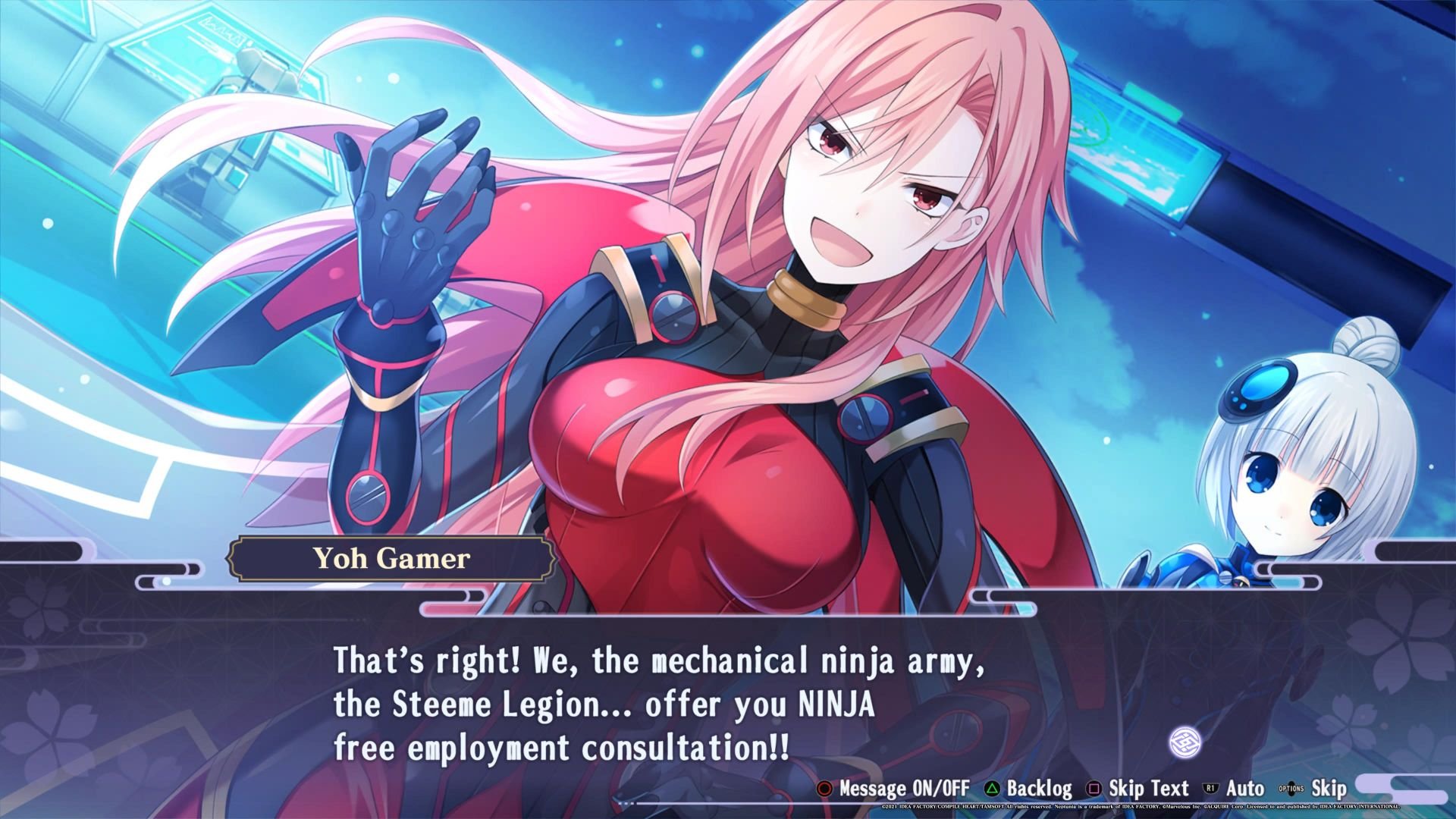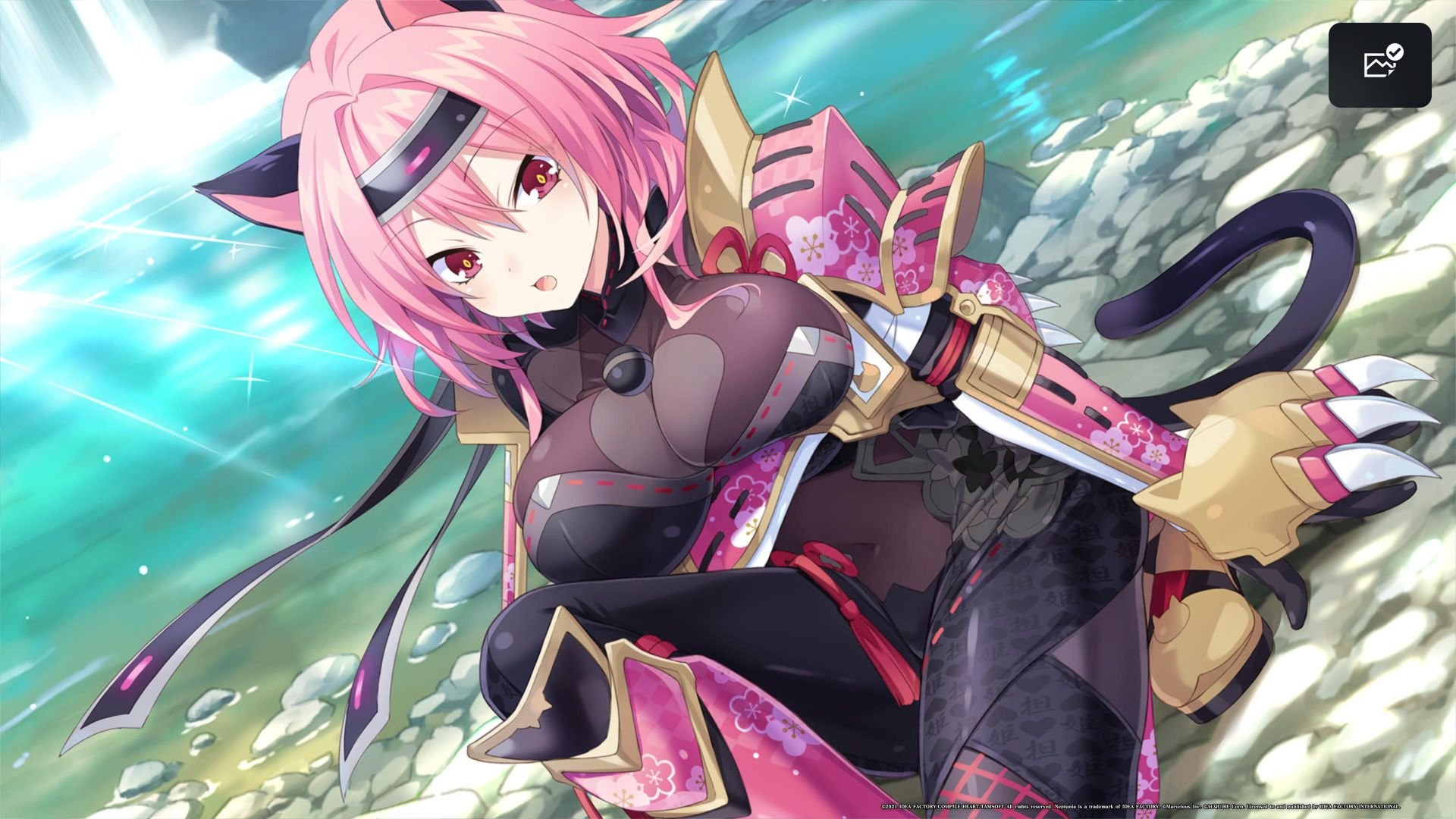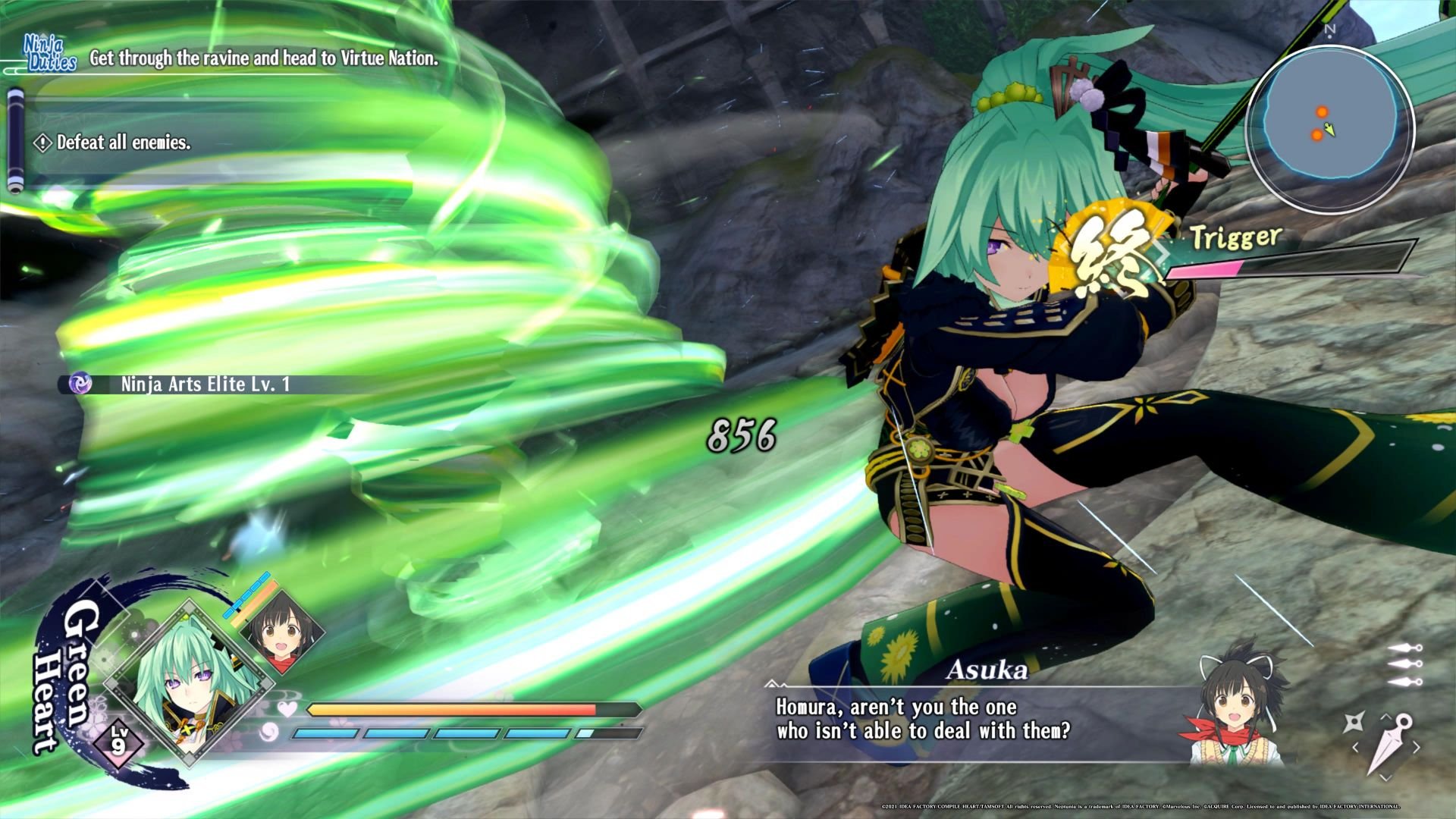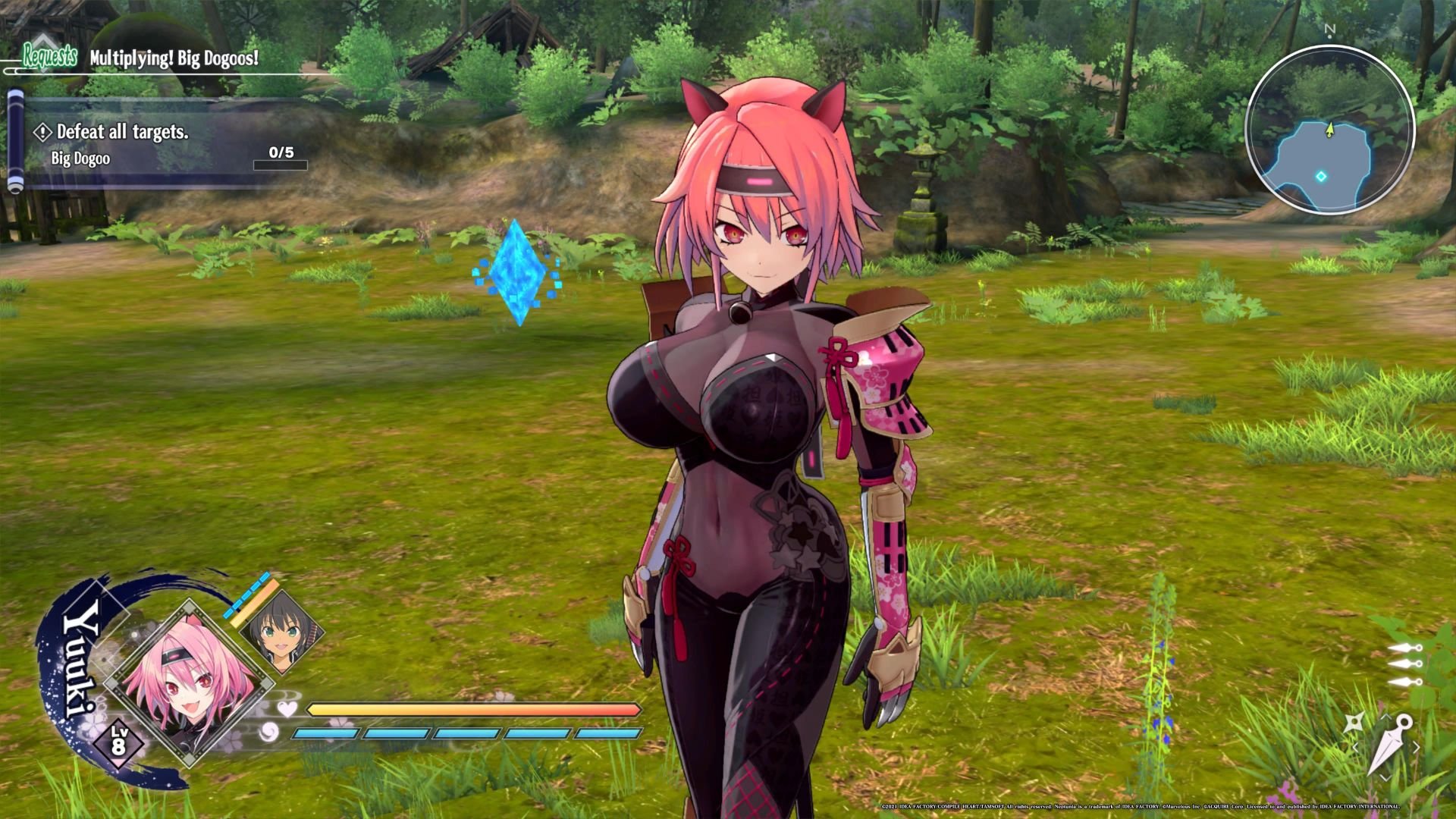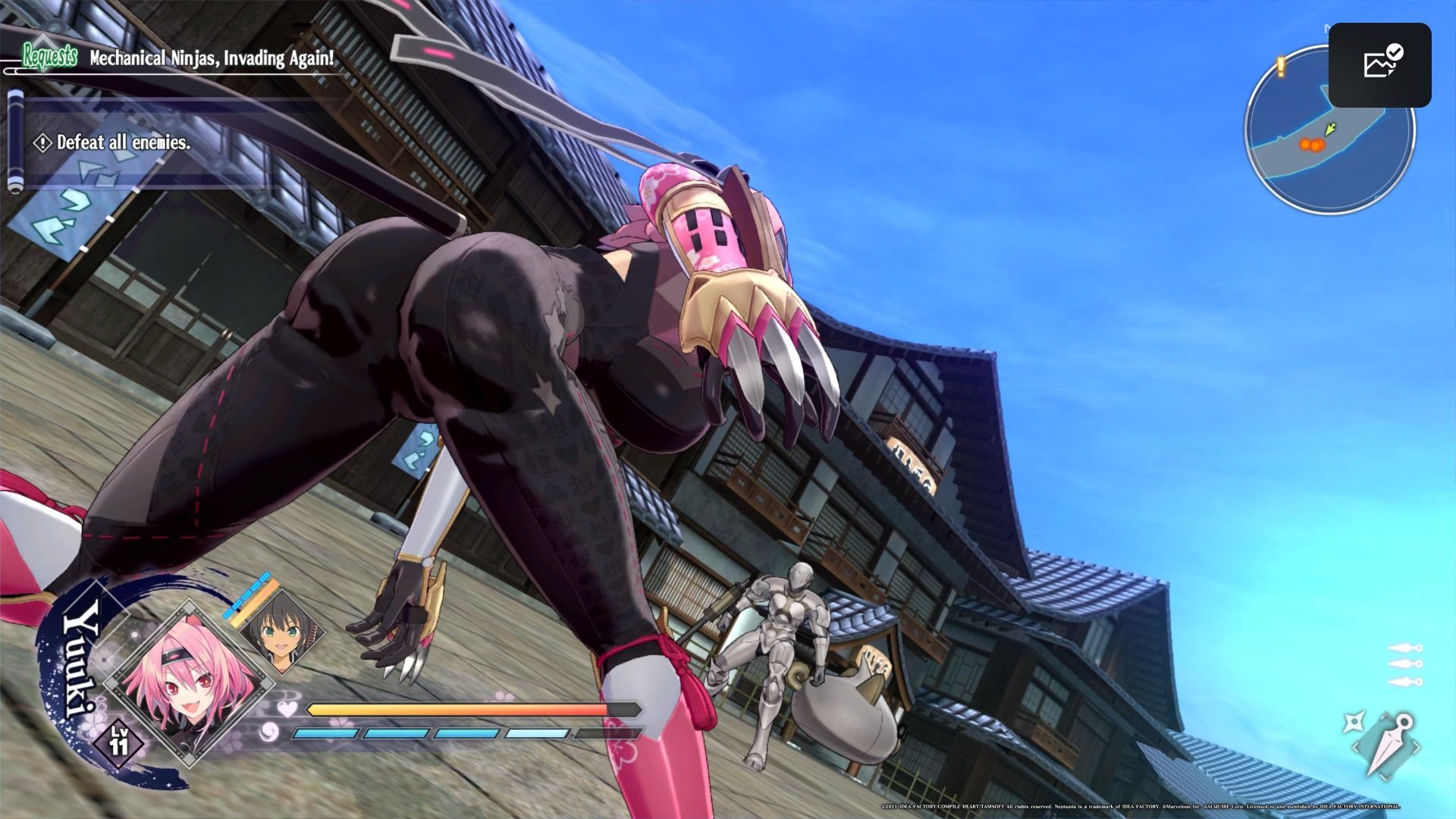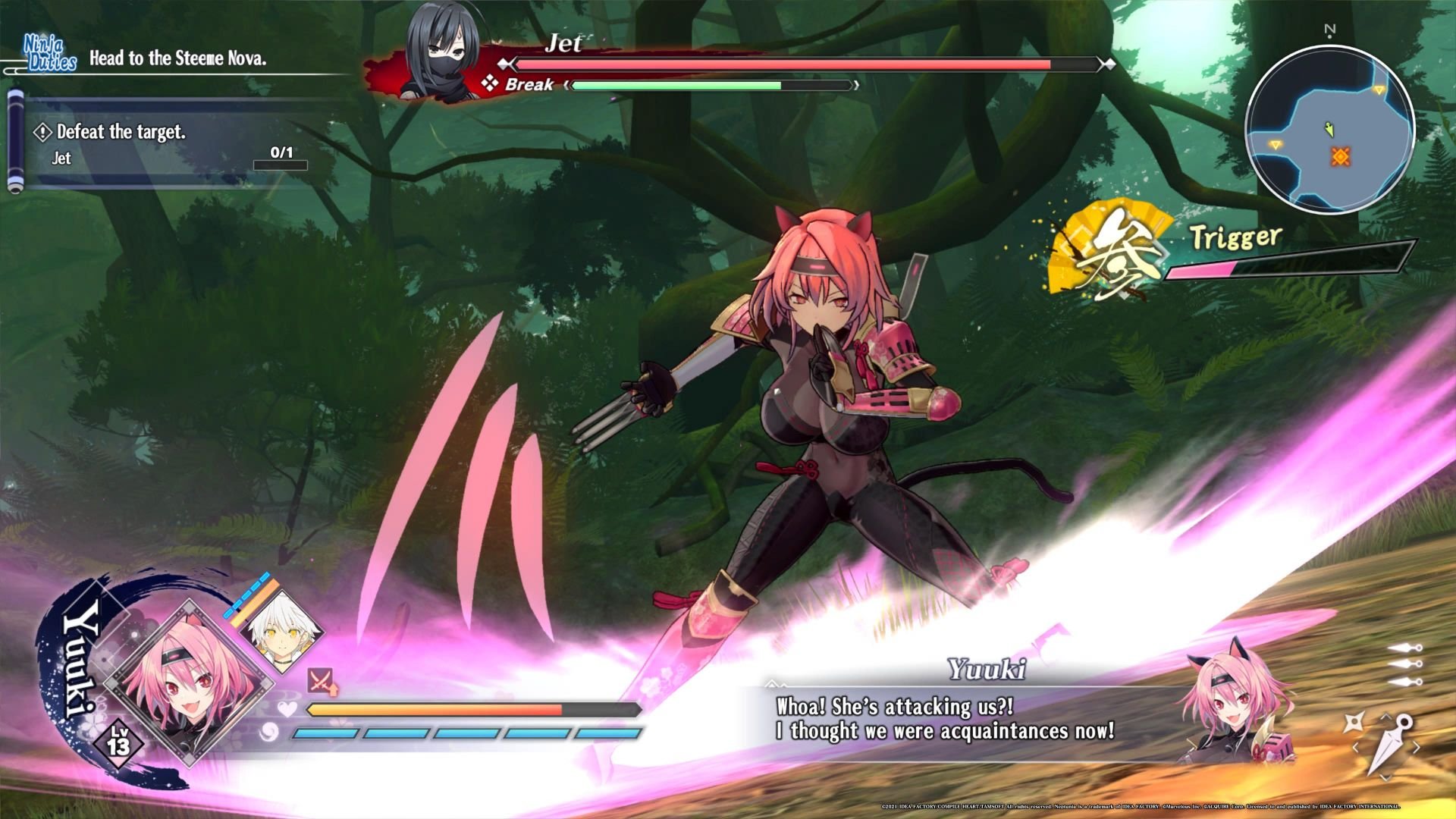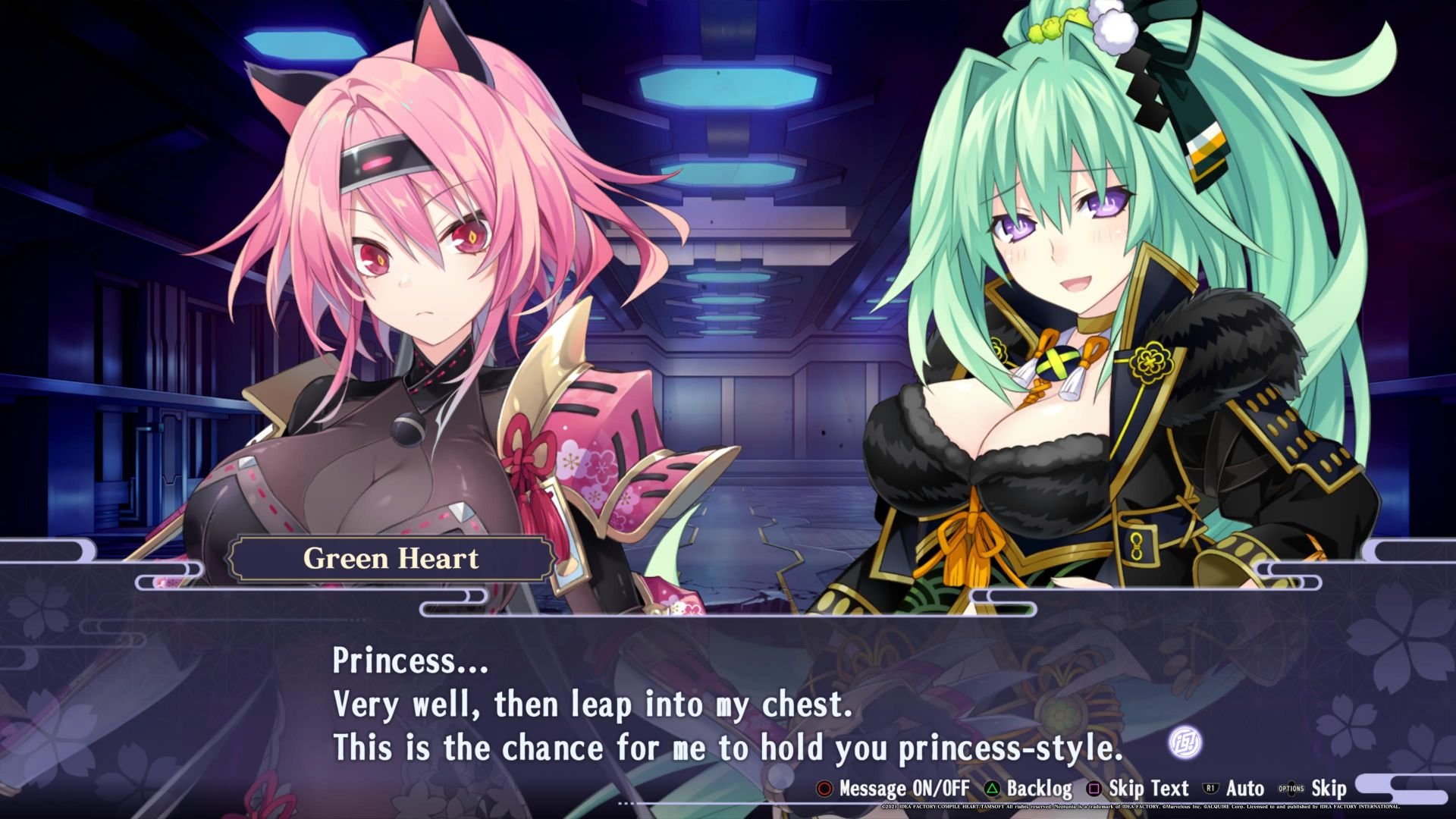Ninja Power.
Neptunia and Senran Kagura both offer their own unique brand of ridiculousness. Neptunia, while it has its own fair share of fan service, is more suited to making in-jokes about gaming and the cliches that exist within it. Senran Kagura, on the other hand, with its library of games, anime, and manga, was created solely for its cheeky and often over-the-top sexualized fan indulgences. When it was announced that these two brands would collide in Ninja Wars, I was curious as to how over the top it would get, given the title’s teen rating. While it distances itself from most of what Senran Kagura usually offers in its own subject matter, we still get a fairly action-packed adventure, albeit with some gameplay issues that greatly hold it back.
Instead of a story where the characters of Senran Kagura are transported into Neptunia’s world of Gamindustri, we get a narrative where the two have been longtime rivals, each living in their own city in the same land, fighting for power, and for pride. Honestly, I am not too keen on this idea as it’s skipped over pretty quickly as the factions are united once the land is invaded by the Steeme Legion, keeping in line with Neptunia’s take that each girl or faction is based on gaming platforms. I do enjoy the story surrounding the Legion, and its villain in Yoh Gamer, but the overarching narrative built around the game is not exactly its strong suit, and is largely throwaway and not terribly memorable. Still, it pushes the story forward into placing the girls into combat, which is the biggest strength of the game by far.
The story of Neptunia, sees Purple Heart and her fellow goddesses, and the cast of Senran Kagura explore 11 stages that have you discovering the intent behind the Steeme invasion, and you’re not going to go at it alone. Joining the 8 franchised girls are Goh, and Yuuki, each capable fighters with their own style. The cast of Neptunia features Purple Heart, Black Heart, White Heart, and Green Heart, each with their alter-ego’s when powered down and not in their goddess forms. Senran Kagura’s choices don’t exactly pick from my favorites, which has been the case with a few of the smaller cast installments of late, but features Miyabi, Yumi, Homura, and the series lead cover girl, Asuka. We don’t get too much information on each girl as it’s largely assumed in you knowing each of these established franchises already. There are certainly attempts at giving some glimpses of that information, but newcomers are not likely to learn much about each of the cast in any great detail.
Goh, and Yuuki, who are original characters to the game are great when it comes to combat. Goh, a ninja who has amnesia is often played for a few laughs, but is quite effective in combat, slicing with long strikes with her katana. Yuuki, a protector of a sacred princess, is honestly, the biggest fan service character this game gives us with her giant.. um.. claws, ahem… slashing their way through pretty much anything. She is super nimble, and most of her attacks deal with some nice distance-covering strikes, or close-range slashes, making her very effective in nearly every type of encounter, especially when those pesky Experience-filled golden blobs show up and you need to attack at them before they disappear.
Gameplay is typical to previous Senran Kagura games in that combat is action-focused and not turned-based, something the Neptunia series is otherwise known for. You can choose a leader and a partner out of the available 10 girls and head into combat, switching between the pair with a press of a button. Environments are typical of what we’ve seen in the Senran Kagura games before and are more or less disappointing from a detailed perspective, but offer up a wide range of maze-like locations often filled with enemies in a few regular spots. I will say that most locations are reused a bit too often when it comes to the side quests, but these missions are crucial to leveling up fully, as the final few chapters are pretty challenging, even if the rest of the game is not. Completing missions will unlock these short side activities in those areas, often unlocked when you talk with an assortment of characters in the Ninchat tab of the hub menu. These range from tracking down gifts, other items, or simply defeating enemies. Ninchat will also offer up short little narratives featuring each of the girls and a few of their antics.
Each of the main missions has you moving through each environment, beating up two types of enemies; Yokai, and the Steeme Legion. Yokai are generally monster-like foes whereas the Legion are more human-looking in nature, often clad in armor and sometimes machine-like in appearance. There are a handful of bosses to fight, some repeated in different colors but it is the AI where Ninja Wars really disappoints as there almost isn’t any. Enemies, for the most part, will sometimes just stand there. This is most common with basic Legion enemies and one or two of the Yokai. After a few hits, they will acknowledge you, but often it’s already too late for them. Yokai mobs and some of the most bruiser Legion classes will target you fairly quickly, especially those that use ranged attacks. However, the most damaging aspect of combat isn’t from any foe, it’s from certain animations during combat.
Some characters, especially Yuuki, have these odd animations where they will sheath their weapon after certain attacks, and this leaves them vulnerable during the entire animation. Had this animation been when no enemies were nearby, I wouldn’t mind it so much, but having it happen while being attacked, just causes you not to be able to respond, unless you happen to have enough stamina to pull off one of your Ninja Arts to move, but it’s likely you’ll be trapped in that animation after that attack commences. Now, thankfully, not every girl seems to do this, at least, not that I’ve experienced. I didn’t seem to find Homura or White Heart do that, but Goh has this shaking of a blade animation that while shorter than Yuuki’s retracted claws bit, is still annoying to have happen, especially when projectiles are incoming.
Apart from those animations, combat can feel a bit delayed and stiff in certain ways. Ninja Arts cannot be canceled out of, and blocking is only good when you are using your main attacks. I also found that the game sometimes will not register the L1 button being held down, and you’ll often have to release and reattempt to pull off your Arts, making for some frustrating encounters, but this was limited to maybe a dozen times during my 20 hours with the game.
Each girl can equip up to four Ninja Arts that are based on each of the face buttons when pressing L1. You do have a basic attack as well as projectiles, but those rarely do any significant damage until much later on when you start getting better gear. Your basic slash will build up stamina, which can be used to dodge, but you’ll often use it to power your Ninja Arts. You can also equip charms, and frankly, the best ones to equip are those that reduce stamina costs, keeping your attacks coming faster as each Ninja Art will consume various degrees of your stamina bar. As you level up, you’ll learn a few additional arts to master, but some girls have a few that are too similar to those they already possess, limiting their growth as a fighter in some small ways. Arts are often flashy attacks, ranging from close-up slashes to charging attacks that bridge the gap between you and your foe. By using your arts, you’ll build up another meter that allows each girl to pull off a special attack, causing enough damage to kill almost anything in one strike, except for bosses, but you’ll still drain their health bars significantly.
While you’ll level up and gain access to more arts, it is the Spirit Gem board where much of your progress will be made. This 5x5 board allows you to slot in gems that are based on a few attributes. These range from incoming or outgoing damage based on each enemy type, raw attack strength, or gaining more experience, money, or gem drops per encounter. Each gem can be leveled up by using Synthesis, a process that combines two of the same level gem. Overall, you’ll get many of your gems from missions, but the majority of them will be through the shop. You can create builds and save them to equip when needed, making it very easy to swap from one set to the next. Once you hit level 40, you’ll have access to the whole board, allowing you to get bonuses for equipping three to five gems in a row of the same type. It’s a decent system that allows you to customize your Ninja how you see fit.
Rounding out the available modes are P&C Meditation and Yomi training. Meditation has you balancing a ball on a spiritual bar, and said ball has your chosen leader resting atop it. Each stage gets progressively harder, with the final tier of difficulty having the ball and bar fade away every few seconds. Successfully winning at this mini-game, which is performed by tilting the Dual Sense controller, will award you with buffs that last for a set period of time. It is here where the game starts to earn a bit of its Senran Kagura moments when your girl falls off the ball and down into the water, giving you a view of their cleavage in typical Senran Kagura fashion.
Yomi Training is a post-game affair that has you diving deep into dungeons that get harder as you progress. While these post-game activities happen in the same environments, the biggest issue is that most of these locations are filled with red-named enemies, who are damn near impossible to kill and can often one-shot you, making these missions just not fun in any capacity. You’ll occasionally find these enemy types in the campaign, but here, they are everywhere, and most of the tasks you’re set to complete are built around simply avoiding all enemies and collecting items within a time limit.
While I mentioned that the environments are nothing to write home about, the character models are rather impressive when compared to previous Neptunia or Senran Kagura games. They offer a nice amount of detail that I wish the environments had, with nice idle animations, bright coloring, and a lot of really interesting designs that are sometimes just different enough from what we’ve had before. Special attacks are wonderfully animated, as are their Ninja Arts, giving each girl a ton of personality, and flavor in their strikes.
Overall, Neptunia X Senran Kagura: Ninja Wars is a decent collab of two franchises that feel perfect for one another. I wish the story was more about their rivalry, as you see Purple Heart and Asuka clashing on the cover, but overall, the adventure is just silly enough to work. I think combat could be refined a bit more to be more fluid from one attack to the next, with proper cancels and a better range of animations that don’t trap you into certain vulnerable states. But if we see a sequel, I think it could honestly have a lot of improvements made to really make it stand out. The Spirit Gem board is nice as it gives you a lot of variety in your builds, even if you’ll likely reach credits just as you unlock your final few slots. Yumi training is far too difficult for what it is aiming to do, and the reuse of the same environments for all side activities does cheapen the overall experience just a bit. Still, if you are a fan of either franchise, I certainly recommend it solely for how engaging combat can be, and the antics each faction gets up to here. It may feel a bit more Neptunia than Senran Kagura, but that’s not exactly a bad thing.
Developer - Compile Heart, Tamsoft. Publisher - Idea Factory. Released - October 26th, 2021. Available On - PS4. Rated - (T) Violence, Suggestive Themes, Language. Platform Reviewed - PlayStation 5 through backwards compatibility. Review Access - A review code was provided by the publisher for the purpose of this review.


